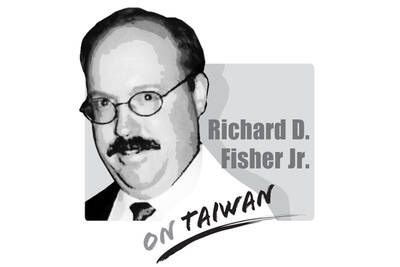Reporting by international wire agencies on Taiwan is often nuanced in a way that backs Beijing’s claims, even if inadvertently. This can mislead readers about everything from the reasons for tension between Taiwan and China to basic facts about Taiwanese and Chinese history — and there are no signs that sloppy reporting will end any time soon.
Careless wording in wire reports can lend credence to Beijing’s portrayal of Taiwan as a “renegade province.” Although a reporter may sidestep the word “country” to avoid taking a stance on Taiwan’s status, alternative phrasing may instead suggest that Taiwan is part of China. Frequent references in wire articles to China as “the mainland” and Taiwan simply as “the island” do just that.
An Associated Press (AP) report on Monday offers an example that is hardly limited to that agency. The report on the Strait Forum in Xiamen, China, said “mainland purchasing groups” would travel to Taiwan to buy agricultural products and mentioned “President Ma Ying-jeou’s [馬英九] policy of allowing more investment by mainland Chinese in the island.”
That wording suits Beijing. While the term “mainland” is appropriate to denote China in the context of Hong Kong and Macau, in an article on cross-strait relations it is misleading. More than geographical proximity, it implies a political link similar to that between China and its two former European colonies.
Wire reports also often contain straightforward and recurring factual errors. The same AP report recycles the claim that “China and Taiwan split amid civil war in 1949,” which also appears in an Agence France-Presse (AFP) article that same day. Read in combination with the terms “mainland” and “island,” the risk of misleading readers is considerable.
This error reduces the historical gap between Taiwan and China, suggesting the two were unified until 1949. That is a version of events that Beijing and the Chinese Nationalist Party (KMT) have both insisted on and that can be dismissed as propaganda. Coming from international media, however, the effect is disconcerting. Independent media enjoy added credibility by virtue of their neutrality on cross-strait developments, but unfortunately what they are reporting in these instances is wrong in fact.
As news agencies often reuse these snippets as inserts, their inaccuracy is all the more unacceptable. Agencies need only get the background information right once, then draw upon it as needed.
Just as disturbing in the AFP report is its unqualified citation of a poll conducted by the KMT-friendly, Chinese-language China Times as showing that “a record number of Taiwanese believe traditional rival China is friendly.”
As a backdrop to this, AFP explains: “Relations between Taiwan and China, which split in 1949 at the end of a civil war, hit rock bottom due to the pro-independence rhetoric of Ma’s DPP predecessor [former president] Chen Shui-bian [陳水扁].”
This has the effect of sweeping under the carpet decades of aggression during which the KMT’s goal was to “retake the mainland” and Beijing’s was to “liberate” Taiwan through force. The blame for cross-strait tension is placed squarely on the shoulders of a president who never advocated aggression. This suits Beijing, which branded Chen a provocateur.
Chiang Kai-shek (蔣介石) may have claimed to rule all of China for decades at the UN, and China may have bombarded Kinmen in 1954, but AFP suggests Chen’s presidency was the nadir of cross-strait relations. Such reports may be laughable to informed readers but others have no cause to doubt them. Professional journalists are obliged to avoid such nonsense.
We are used to hearing that whenever something happens, it means Taiwan is about to fall to China. Chinese President Xi Jinping (習近平) cannot change the color of his socks without China experts claiming it means an invasion is imminent. So, it is no surprise that what happened in Venezuela over the weekend triggered the knee-jerk reaction of saying that Taiwan is next. That is not an opinion on whether US President Donald Trump was right to remove Venezuelan President Nicolas Maduro the way he did or if it is good for Venezuela and the world. There are other, more qualified

This should be the year in which the democracies, especially those in East Asia, lose their fear of the Chinese Communist Party’s (CCP) “one China principle” plus its nuclear “Cognitive Warfare” coercion strategies, all designed to achieve hegemony without fighting. For 2025, stoking regional and global fear was a major goal for the CCP and its People’s Liberation Army (PLA), following on Mao Zedong’s (毛澤東) Little Red Book admonition, “We must be ruthless to our enemies; we must overpower and annihilate them.” But on Dec. 17, 2025, the Trump Administration demonstrated direct defiance of CCP terror with its record US$11.1 billion arms
China’s recent aggressive military posture around Taiwan simply reflects the truth that China is a millennium behind, as Kobe City Councilor Norihiro Uehata has commented. While democratic countries work for peace, prosperity and progress, authoritarian countries such as Russia and China only care about territorial expansion, superpower status and world dominance, while their people suffer. Two millennia ago, the ancient Chinese philosopher Mencius (孟子) would have advised Chinese President Xi Jinping (習近平) that “people are the most important, state is lesser, and the ruler is the least important.” In fact, the reverse order is causing the great depression in China right now,
As technological change sweeps across the world, the focus of education has undergone an inevitable shift toward artificial intelligence (AI) and digital learning. However, the HundrED Global Collection 2026 report has a message that Taiwanese society and education policymakers would do well to reflect on. In the age of AI, the scarcest resource in education is not advanced computing power, but people; and the most urgent global educational crisis is not technological backwardness, but teacher well-being and retention. Covering 52 countries, the report from HundrED, a Finnish nonprofit that reviews and compiles innovative solutions in education from around the world, highlights a